
it comes to health and wellness, medical experts are always coming up with new therapies. Among all the options, there are two that really stand out as the best. So, what are they?
None other than infrared and red light therapy.
Both have a specific wavelength of light, but what actually keeps them apart is that their mechanisms of action and applications differ. Now, the real question Is, is there anything else different between these two therapies? Which one is better?
We will answer all of your questions. By the end, you will know why we named it Red Light Therapy vs. Infrared Light Therapy and which therapy may be the best fit for you.
Understanding Red Light Therapy
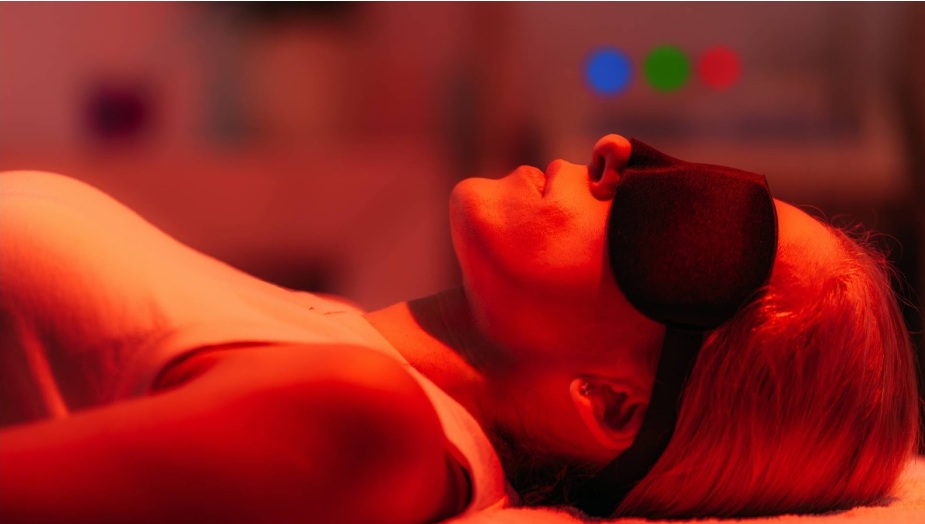
What Is Red Light Therapy?
You might have heard about the work of photobiomodulation from your doctor while looking for therapies. This is actually the scientific name of Red light therapy. The light it uses on the skin has a specific wavelength that offers different solutions for bodily issues. It exposes your body to wavelengths ranging from 630 to 700 nanometers to go under the skin to restore cellular function.
How Does It Work at the Cellular Level?
The work of red light therapy is connected with the mitochondria—yes, you guessed it right—the powerhouses of cells. The effectiveness of red light therapy depends on how it stimulates the mitochondria.
It lets light interact with mitochondria just to increase energy production. This improves cellular function, repairs cells, and reduces oxidative stress.
Key Benefits of Red Light Therapy
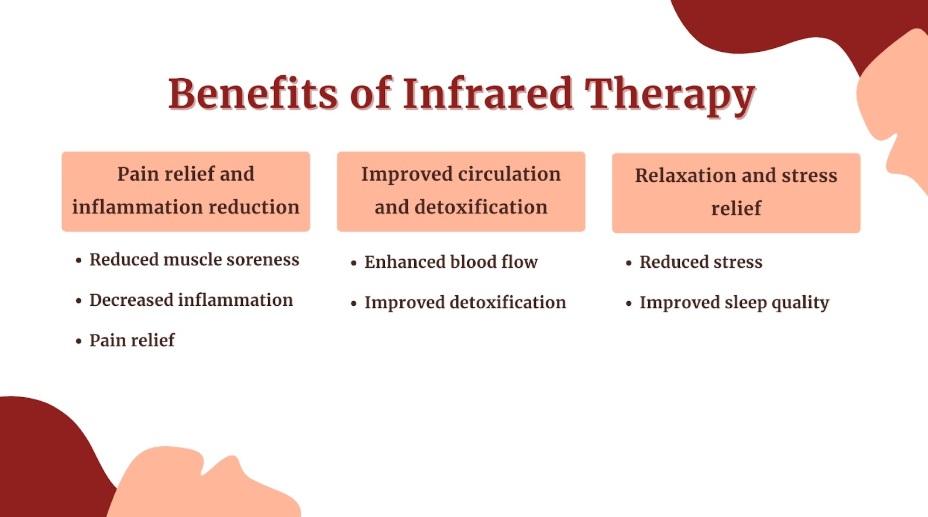
Skin Rejuvenation and Anti-Aging
- Are you seeing wrinkles and fine lines? Red light therapy revives collagen and elastin production, improving your skin texture and firmness.
- Do you want to lighten up your hyperpigmentation? This therapy can help you fade away hyperpigmentation and even tone the skin.
- Are wounds not healing? Red light therapy is known for cellular repair, so it will heal cuts, burns, and injuries much faster.
Muscle Recovery and Wound Healing
- This therapy will reduce skin inflammation, and the pain you feel will also disappear.
- It will increase your blood flow and oxygen level to repair your damaged tissues for faster repair.
- People in the athletic field will get a lot of benefits for their muscle soreness and fatigue.
Mood Enhancement and Energy Boost
- Red light therapy has shown positive effects on moods and mental well-being.
- Because of cellular energy products, fatigue will go away, and it will give you an energy booster.
Ideal Use Cases for Red Light Therapy
One more thing you will see in Red light therapy is that your dermatologist also recommends it for skin treatment. Why? Because it is particularly effective for skin and superficial treatments. These are the skin concerns it deals with:
- Acne
- Rosacea
- Sun damage
- Psoriasis
- Eczema
Understanding Infrared Therapy
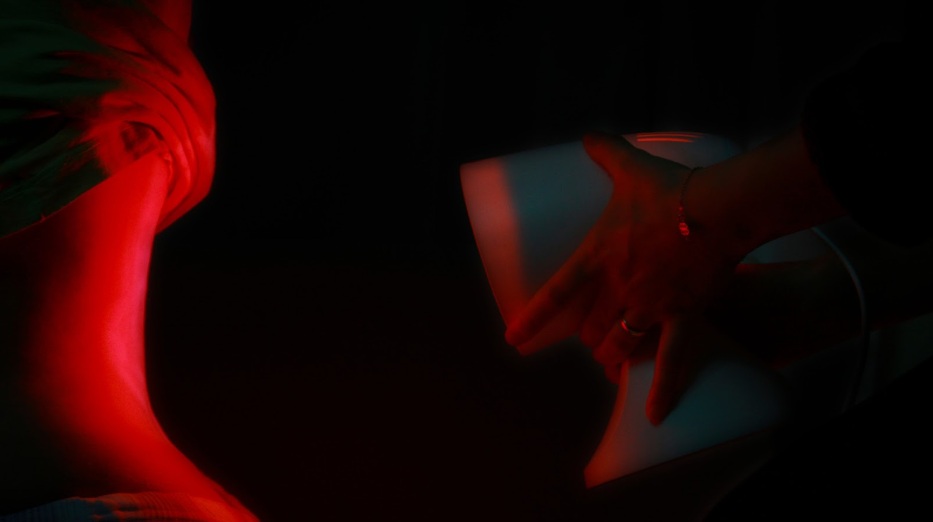
What Is Infrared Therapy?
This is another one from light therapy. This one you can not see with your naked eyes. This invisible light can only be felt as heat. Compared to red light therapy, it has much more wavelengths and goes deeper into the skin. Not only the surface skin but penetrates about 1.5 inches into the skin.
If you ask about the wavelength ranges, then it comes between 760 nm and 100,000 nm, a lot more than red light therapy. Because of that, you get to feel the heat and other physiological effects.
Key Benefits of Infrared Therapy

Pain relief and inflammation reduction
- If you are feeling too much muscle soreness and stiffness, infrared therapy can help ease the pain.
- As this therapy increases the blood flow, there will be no inflammation or swelling to worry about.
- The heat from the infrared light soothes the pain associated with arthritis, fibromyalgia, and other chronic conditions.
Improved circulation and detoxification
- Infrared washes out all the waste products from the body by increasing blood circulation and carrying enough oxygen and nutrients to tissues.
- This therapy is always on the run to detoxify the body. It stimulates sweat production to help the body eliminate toxins.
Relaxation and stress relief
- Another benefit of heat infrared light is that it relaxes you and reduces any stress you are experiencing.
- It will definitely give you a good night’s sleep just by relaxing your body and mind.
Ideal Use Cases for Infrared Therapy
Infrared light is great for helping with deep-tissue healing and relaxing muscles. It’s pretty well-known for that. You’ll usually come across this type of therapy in places like physical therapy clinics or saunas. Plus, it can help with a bunch of other issues, too:
- Muscle injuries
- Joint pain
- Chronic pain
- Sports injuries
- Skin conditions
Infrared vs Red Light Therapy: Key Differences
These two therapies are really popular right now in the physical therapy world. At first, they might look alike, but they’re actually quite different. Just because they both use lights doesn’t mean their work is the same, and there are significant differences that make them stand opposite each other.
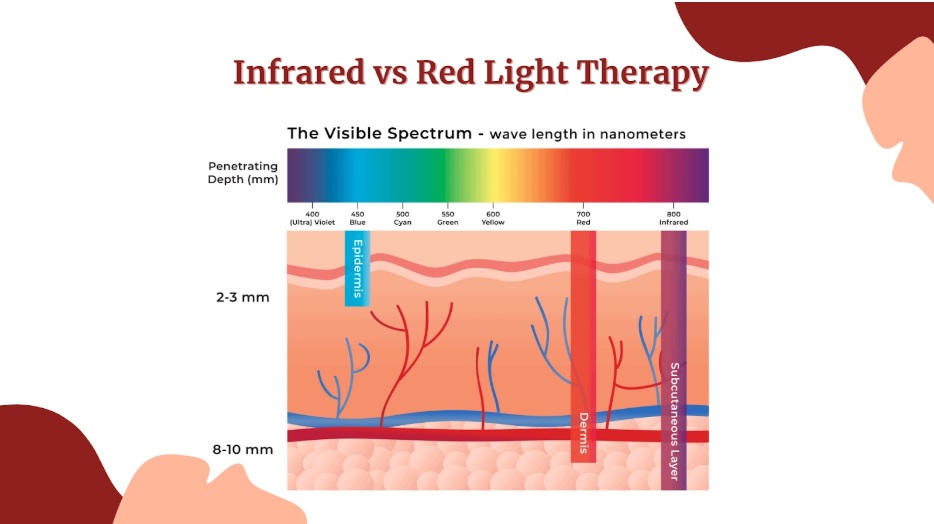
[Source: Blue Light vs Red Light vs Infrared – HealthLight]
Let’s understand the difference between infrared light and red light therapy so you will know which one to go for next time you think of getting one that fits your needs.
Mechanisms of Action
Infrared and red light therapy both use specific wavelengths for their healing effects, but they work in pretty different ways.
Infrared Therapy:
Thermal Effect: Infrared therapy works as a gentle heat source that gets absorbed by the skin and underlying tissues. What this heat can do is:
- Increase blood flow and deliver oxygen to tissues
- Relax muscles and reduce spasms
- Relief the pain by releasing endorphins
- Promote sweat to make the body free from toxins
Red Light Therapy:
Photochemical effect: Red light is taken into the mitochondria in the cell, triggering ATP (adenosine triphosphate) production to repair and regenerate cells faster than ever. This can:
- Enhance collagen production
- Bring even skin tone and elasticity
- Reduce inflammation by modulating the immune response
- Faster tissue repair and wound healing
Depth of Penetration
The wavelength of the light decides how deep the penetration will be into the tissue. Let’s see what wavelength limit these two therapies have and how they will work on your skin.
- Infrared Therapy: Infrared light uses a 760 nm to 100,000 nm longer wavelength for deeper penetration into the tissue. It works on both the skin surface and underlying muscles and joint structures.
- Red light therapy: A shorter wavelength (630 to 700 nanometers) penetrates only the surface of the skin. These wavelengths target superficial injuries and skin-related issues that don’t require longer exposure to the light.
Here is the visual image of their wavelength spectrum:
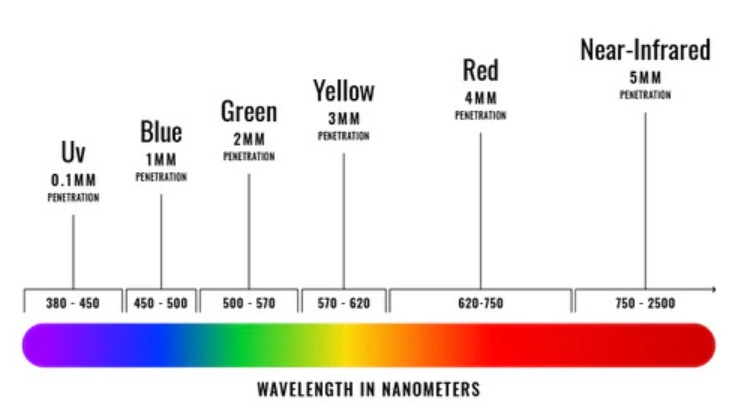
[Source: Red Light Therapy vs. Infrared Light Therapy: Which is Better for Anti-Aging Treatment?]
Conditions Each Therapy Treats
| Condition | Infrared Therapy | Red Light Therapy |
| Skin | Limited solutions | Acne, rosacea, eczema,
Psoriasis, sun damage, anti-aging |
| Muscles | Muscle pain, soreness, DOMS, muscle injuries, joint pain, arthritis | Limited solutions |
| Wounds | Wound healing and surgical recovery | Wound healing and surgical recovery |
| Cardiovascular Health | Dilation of blood vessels improves blood circulation, lowers blood pressure | Nothing particular |
| Detoxification | Eliminate toxins from the body | Nothing particular |
| Overall Wellness | Stress relief, improved sleep, pain management | Mood enhancement, reduced inflammation, increased energy |
Choosing the Right Therapy for Your Needs
Both therapies are seen as effective solutions and are even considered non-invasive treatments for various health concerns. It is just that both of these techniques use different wavelengths that initiate different stages of the biological process of healing.
So, after all the back-and-forth, you might be wondering: which one should you go for, infrared light therapy or red light therapy? Feeling a bit lost? Don’t worry; let’s clear things up for you!
What Are Your Health Goals?
Yes, this is the question you should ask yourself first. Before deciding on any of these treatments, consider what is your specific health issues you want to solve:
Skin Health:
- Red light therapy works best for skin-related issues, such as making the skin look more even, removing wrinkles, and rejuvenating the skin.
- Infrared therapy also benefits skin health through blood circulation and detoxification.
Pain Relief:
- Infrared therapy can treat any kind of muscle pain, including muscle spasms, injuries, joint pain, and more.
- Red light therapy treats chronic pain by reducing inflammation.
Relaxation:
- Infrared therapy provides relaxation throughout the body by releasing endorphins when muscles and other pain are relieved.
- Red light therapy also has a calming effect on the body and mind but at a limited level.
Combining Therapies for Maximum Benefit
In many cases, you can combine infrared and red light therapy for synergistic benefits. Here is how it will work:
- Enhanced Skin Rejunaviting: Where red light therapy can help with collagen production, infrared treatment will focus on blood circulation. As a result, you will have healthier and more radiant skin.
- Improved Pain Relief: Since infrared penetrates deeper into your skin, it is easier to repair painful tissues. On the other hand, red light therapy reduces inflammation and heals wounds faster.
- Optimal relaxation: For relaxation, you can rely on infrared therapy, which relaxes muscles and induces deep relaxation, while red light therapy calms the mind.
Practical Tips for Combining Therapies:
These tips are meant to help you make choices that fit your needs. It’s always a good idea to consult with a doctor first about whether combining infrared and red light therapy is a smart move. Also, whatever therapy you pick, start with shorter sessions and see how your body responds.

Best Devices for Home Use
Top Picks for Red Light Therapy Devices
The Biomax 300 is the smallest in BIOMAX’s latest range. It’s designed to help hair grow back, improve skin texture, and keep skin wrinkle-free.
Key Features:
- Touchscreen system with Bluetooth controller
- It 100 LEDs
- The approximate irradiance level at 36” is 68 mW/cm²
- Max heat 130F/ 55C
- This device only targets surface-level issues.
BIOMAX 600 works on your entire body at once. It targets all those big muscle areas, getting you pumped up for your next run or match, and it helps boost your mitochondria cell production.
Key Feature:
- Full body treatment
- Digital control and timer
- Features 200 LEDs
- Provide an approximate irradiance level of 85 mW/cm² at 36 inches
- Max heat 130F/ 55C
- Beneficial for skin rejuvenation and healing.
Factors to Consider When Buying
- Figure out the budget
- Think about the intensity of the light
- Ensure the device is certified and meets safety standards
- See if the device has a good warranty
- Read reviews from other users to get insights
Are There Any Risks or Side Effects?
There aren’t any severe side effects for both infrared and red light therapy. Both are considered safe. But following safety guidelines or taking precautions won’t harm anyone. They will protect you from any potential risks.
Safety of Red Light Therapy
Common side effects:
- A typical side effect that most users see is a slight redness on their skin after a longer session. It usually goes away after a few hours.
- Exposing your eyes to light for a long time can temporarily strain or discomfort them. That’s why you should wear eyewear to protect your vision during the session.
Precautions:
- Avoid direct exposure to red light and wear eye protection during the session.
- If you already have any underlying health issues, then please discuss them with your doctor before going for light therapy.
- Follow all the manufacturer’s instructions regarding the duration of treatment.
Safety of Infrared Therapy
Risk of Overuse:
- Prolonged exposure to heat can make you feel dehydrated.
- Overexposure to heat can increase the risk of heatstroke if it’s hot and humid.
- Excessive can leave sunburns on the skin.
- In some cases, exposure to heat can increase the risk of high heart rate and BP.
Precautions:
- Hydrate yourself during the long session
- Use the infrared therapy at a safe distance and monitor your skin
- Listen to your body’s responses and avoid excessive heat exposure
Expert Tips for Maximizing Therapy Results
How to Create a Therapy Routine?
Whatever therapy you choose, whether infrared or red light therapy, you will still need to have a consistent routine to see the results.
- Frequency: Experts suggest going for 2 to 3 sessions per week for optimal results.
- Duration: Each session can last 10 to 20 minutes. Shooter sessions are easy to manage in a hectic lifestyle, and longer sessions are best for specific conditions.
- Consistency: Consistency will always pay you off. So stick to your routine and avoid missing sessions.
Complementary Practices to Enhance Benefits
If you want to really boost the benefits of infrared and red light therapy, try adding these extra practices to your routine:
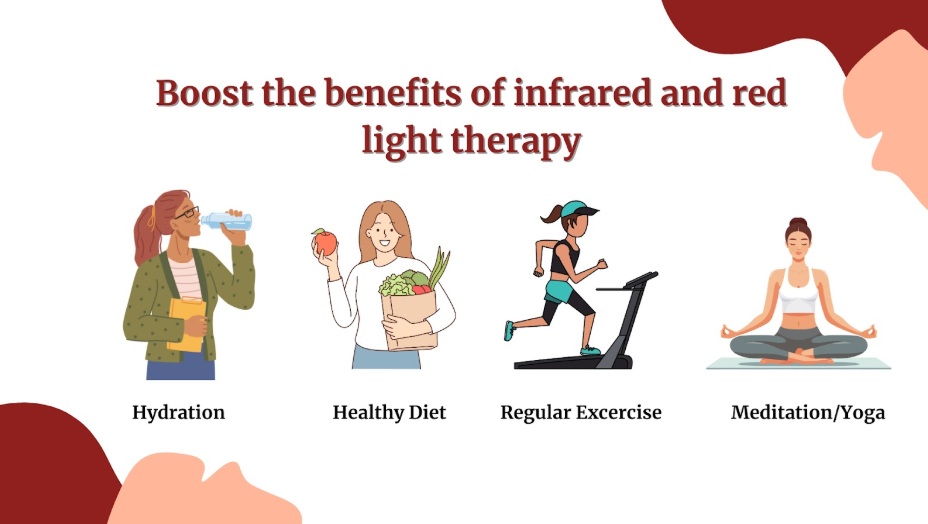
Frequently Asked Questions
What is the main difference between infrared and red light therapy?
The main difference is that infrared therapy uses a longer wavelength to generate heat and penetrate deeper into the tissues, while red light therapy uses a shorter wavelength to stimulate culture processes.
Is infrared therapy better for pain relief than red light therapy?
Both can be effective if you ask. Since infrared light goes deeper into the skin layer, it is more likely to fix joint and muscle-related pain.
Can you use both therapies together?
Yes, you can combine infrared and red light therapy to maximize both sides’ effectiveness in your treatment.
How often should I use red light therapy for skin benefits?
You can go for 2 to 3 sessions weekly for optimal skin benefits.
Are there any side effects of infrared or red light therapy?
Both therapies are considered pretty safe, but red light therapy might cause temporary skin redness or eye discomfort. Infrared therapy, while rare, can sometimes cause issues with heat reflection.



